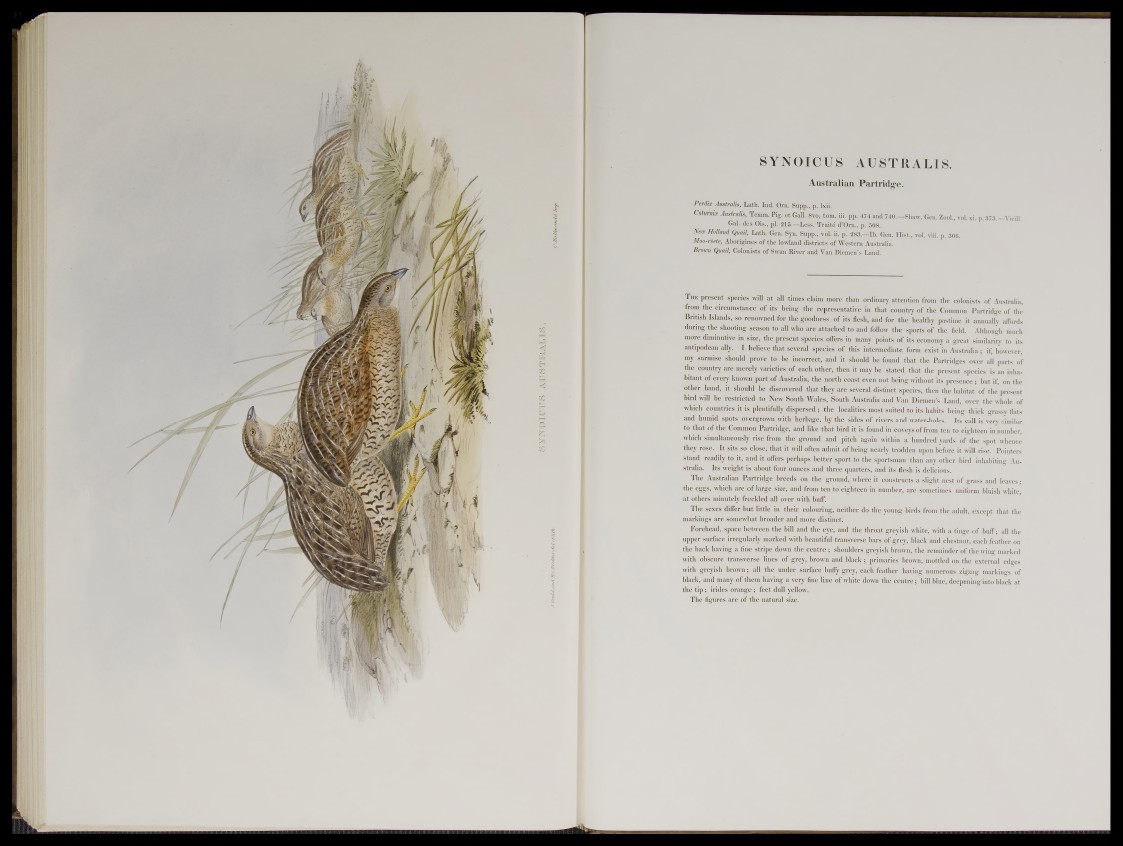
s'MMiilfiT S tasTE; «swaniHi
SYNO10US aW t RALIS.
Australian Partridge.
"Pertbi A ust'um, l
4.7-^ p Mfe sh aw .1 Gen. Zool., voL » . p.*7S.—VieilL
JBrmn tjw. ™d^VandWuCT&Slnir*' t
^EHBspreseiLt -I" g g B B l g l - , I u m i |j g t h a n ^ d S ’ittentijqn from t ^ W s of Australia,
ibi'SVrunoii'L'.irtridifo of the
B p tth IkfjimK.m renowned f ir tin. goodness of y-JU and for tin «fioilthv affords
lifi .lan^ (jimTiTo dU lio the .ports ot flu £5 $ * ilth o ^ h much
m o r c r d j ji ^ a i ^ ^ si/ i ilie pn .1 i'jjjb rg an 1 $ g i i i t similarity to its
annitijlli^ ij'jlly ^ p IjiJiiMj . ' this uili rim i fate form howevisr,
^ aM ,rriii-i should iin u u ret f/anil i r f ^ i i j d f ^ ^ ^ ^ t i . i n ’the Partridges over ail parte of
the cauntrv ire i it h othij . th iS itB ^ t hp Staled S hTM-’ prt 51 m species is an inhai
p 1I? i r a K ® 1-oov.r^p mgjjh \n-.ti ill 1 sTngTuirth 1 D usl^ t i r ^ ^ ^ ^ u'rtiiimi>iK~^r. nne • bnt if, on the
^ 'e r ^ h ftjf eU t shpuld be discovered t h a t - t h e w t h e n the habitat of the present
f s S w t f l be restricted t b ^ |w South Wales, S o u t ^ M ^ h a and Van Diemen’s Land, over the whole of
«B&jjg»' v .t ^ ^ w i ^ i v d j j i a r w l ‘ tht localities moat suited to It^?lxsblts7 i^ in g .-thW .grassy flats
w tiy w fm '# * * u«rtCC'jwu1-wiiU j g j j p ^ j i y the riv e r|t&lH 4 fo j;h§Ies. Its call is very simSar
111 lin t I t til ( imini n I* irli d i jimjilihi whit bird it s f c n d it^ f f l^ S ttrm ! ! ten to eight« 11 ihhdmhe*-
't® e h t im u l t a n e o u s f |ig l^ i t h e i f t ^ d * igni” u ^ EthSndreiT' aril^Ththe »jot wbem*
W lM rose. I t sits ^ r i ^ t e n adinjryl b'^ ^ ^ ^ ^ y w d 'S SB S f f i t f o n ^ lK i ^ s ’e Pointers
stand readily offers perhaps better sptiytto the | » g m | j than|my.otblr1bM'"inhabitiBg Australia.
Ifc wi iglit is about tour ounce^ and th r|v7i 5 g ? ^ / g u f,1 s jli ^TsVlJifj'iius \
The Australian Partridge" bleeds 'm n w n s t? u ^ j« l.*i!?l'«~n.'st »1 grass and leaves;
B w eggs, wbioh'-are of large size, abdJfrom t e K o ^ g h ^ i fM ^ SM a ffamiometimes uniform W ish white,
BBRSthers mjautelY-'freckled all ovenjyith buff.
IP 's sexes’differ bnt little i |m e i r cohjuririyn f i t f j ^ ^ j^^wiiini- birds f rW the adult, except that the
markings are somewhat broader aud moreidMmhEr t ■ • 1-
Fort head, -pan hetwnn rhe lji.ll anjfjlw eye, and the ,]„B
upper surface irregularly marked with beautiful' transverse haryof grot, black andphpWV each feather on
the back having a finft~etrinefd6wpthe 'centrei.^ ^uW eqfert.'.ish jjjgljiktlfe remSndlr^&ibe wing marked
Mffl obscure transveisedm^gfiW S 'i>rottti aniiUaek>,_ primaries bi own.smp^S^u.the.externaJ edges
$ j j | greyish bw^m; aB the Ofid^%f^.eVfJy grey, e a a ^ ^ f c ^ a v iD g ^ ^ ^ ^ l ’^ a g markings of
black, and many of them having^,very fine li^eM'white dpwn thelcffitre; biff blue,»deepenimrinto black at
the tip; irides orange; feet dolliyellow.
The figures are of the natural size.